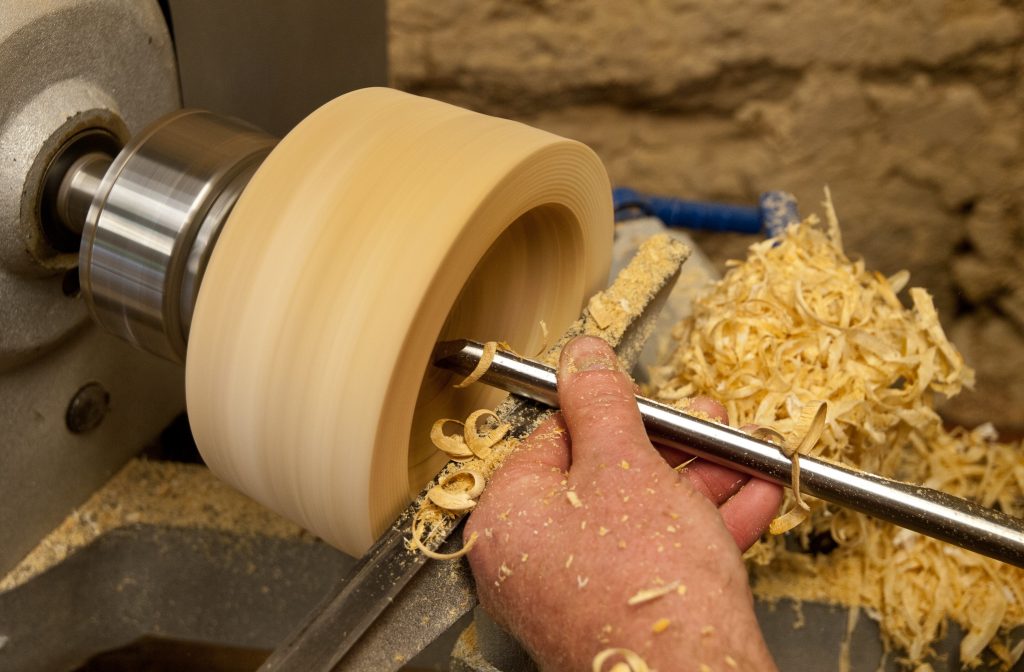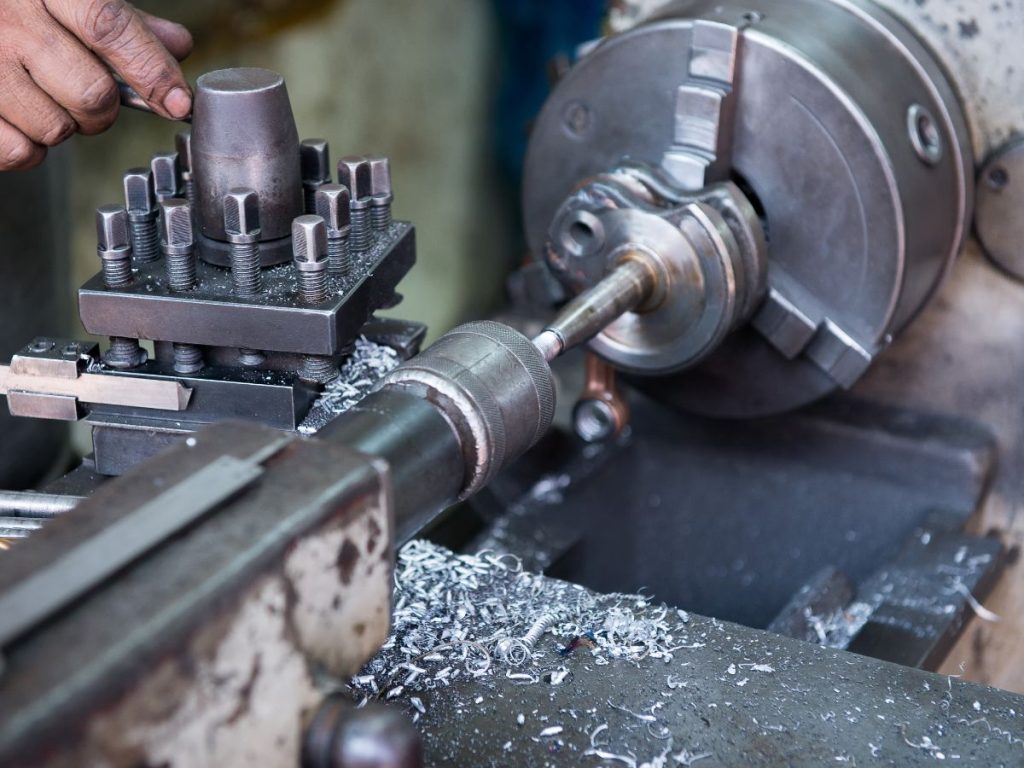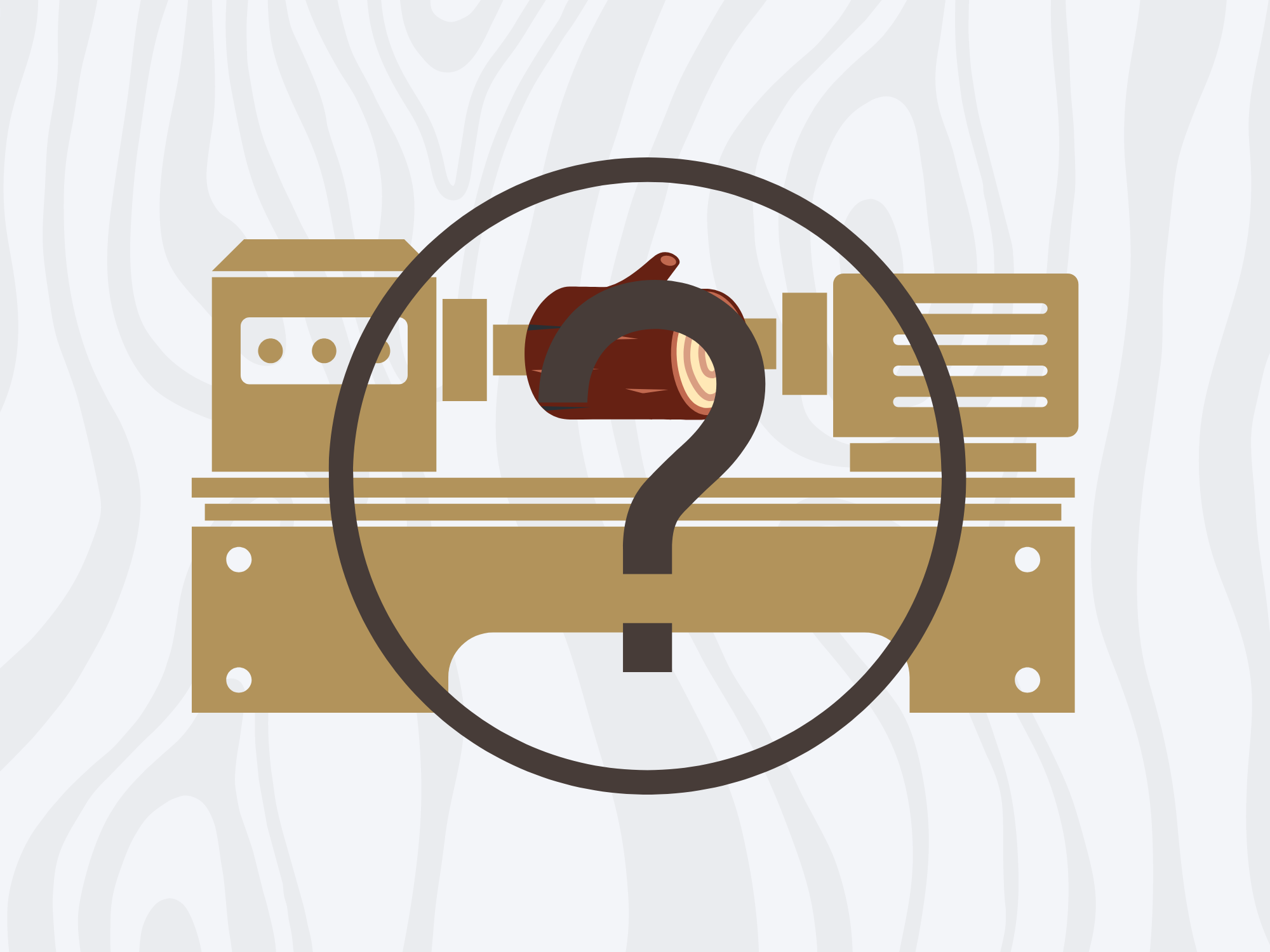If you work creatively at home or have an artist’s studio, you may be wondering if it is possible to turn wood on a metal lathe. Can you turn wood on a metal lathe safely, or will this damage your equipment?
Table of Contents
- How Do You Turn Wood on a Metal Lathe?
- What are the Benefits of Woodworking with a Metal Lathe?
- When Should I Use a Wooden Lathe for Woodworking?
- Can I Turn Metal on a Wood Lathe?
- How To Care for a Metal Lathe That Carves Wood
- Is The Quality of Woodwork Improved with a Metal Lathe?
- Are All Metal Lathes Alike?
- Should I Buy a Metal Lathe For Woodworking?
- Conclusion
Turning wood on a metal lathe is possible and is a great way to do detailed woodworking. However, a craftsman will want to avoid attempting to turn metal on a wood lathe, as this can cause chatter or intense machine vibrations which can damage the lathe.
A lathe simply holds an item in place as your turn it and carve it. It’s one of the best specialized tools to have on hand, helps woodworkers create beautiful pieces quickly, and is a priceless tool to have in your workshop.
See what is the difference between metal and wood lathes, or keep reading to learn more about how to woodwork with a metal lathe, and what makes this item so valuable to a craftsman.
How Do You Turn Wood on a Metal Lathe?
Turning wood on metal lathes follows very much the same process and techniques as on similar woodturning tools. Watch your setup, and make sure that the lathe is secured before attaching workpieces.
You’ll want to secure the piece of wood that you’ll be turning, and trace a profile (make sure the wood is dry enough). Next, you’ll increase the metal lathe speed, and work your wooden object to its desired specifications.
Make sure that the headstock and the wood rest are both adjusted properly for the size of the wood you’ll be working with. Your tool holder should also be secured, and the tool post should be appropriate for the material being worked on. Make sure your tool rest is secure, and check connections before woodturning.
You won’t need much additional tooling for this project apart from your chisels, and a metal lathe can handle any variety of wood. So what makes metal lathes more desirable as a machine for woodworking?

What are the Benefits of Woodworking with a Metal Lathe?
Carving wood on a metal lathe has several advantages, thanks to the increased heft and weight of the tool itself.
- Metal lathes are far sturdier and tougher, making them better suited for a variety of woods, including hardwood
- Their increased weight means you’ll have fewer vibrations or “chatter” as you work
- Metal lathes can rotate and lower speeds, whereas wooden lathes tend to rotate a bit faster
- Metal lathes tend to accomplish detailed, fine carving on wood projects
You’ll get a much finer, more detailed pattern with a metal lathe, as well as better control over speed and finer precision. While a metalworking lathe is perfect for many projects, you’ll want to hold off on woodworking with a metal lathe under certain circumstances.
When Should I Use a Wooden Lathe for Woodworking?
A woodturning lathe is ideal if your workpiece is long or has a wide circumference. Wooden lathes are designed to handle shavings, sawdust, wood chips, and the debris inherent in woodworking projects. These same shavings are capable of jamming a metal lathe if allowed to pile up.
While a metal lathe works fine for many projects, a wooden lathe will be best if you’re looking to create something larger and wider from wood. A wood turning lathe is also ideal if you need speed over precision. In addition, if you don’t already do metalworking in your shop, a wood lathe will suit your purposes just fine.
Can I Turn Metal on a Wood Lathe?
Be sure to avoid turning metal on a wooden lathe. These tools are means only for use with wood, and attempting to work metal on such a machine could cause serious equipment damage.
You’ll also notice some intense vibrations or chatter as you work, which can be distracting, and even dangerous. While these machines both work the same way, they’re designed to handle very different materials, and using a wood lathe to carve metal is a bit like using a VW Bug as a monster truck. It’s just not a good idea.
So how do you care for a metal lathe that is being used for woodworking? Are there any special lathe care practices to consider?

How To Care for a Metal Lathe That Carves Wood
If you’re going to be using a metal lathe for your next woodturning project, your main concern is going to be a buildup of dust or wood debris around and in the lathe. This will collect as you drill and as you sand, and the resulting dust can harm your lathe if left to collect.
The best process to undertake is to clean your metal lathe after every woodworking session. Using a metal lathe to turn wood is great for your woodturning project, but the steel of the machine can get clogged. Keep it clean, and you’ll be fine.
Is The Quality of Woodwork Improved with a Metal Lathe?
So what value does a high-qulity metal lathe bring to projects? Using a metal lathe to turn wood can result in some beautiful, precise work. Your work will progress a bit slower, as the rpm of metal lathes is a but slower than wood lathes. While your projects will take a bit longer, they’ll be beautiful and detailed, and the precise work can help you cut back on wood chips, dust, and debris.
Turning wood on metal lathe can give a craftsman some incredible control over detail and produce some smoother wood. You’ll still need to sand, but compared to wood lathes the end result will be finer and more precise. These machines can also handle a greater variety of materials, so if you know you’ll be working in metal as well as wood, the precision and convenience will be worth it.
Your wooden workpiece will have not only a better appearance, but can be carved without the need for specialized equipment, apart from your standard chisels . Cutting time will be increased a bit, but the added beauty makes the lack of speed negligible. Machining is easier, and your lathe will be more secure.
It’s important to keep in mind, though, that not all metal lathes are created equal, and that buying a metal lathe just for woodworking wouldn’t make a lot of sense for most woodworkers.

Are All Metal Lathes Alike?
While a high-quality metal lathe can be an asset for those who work in wood and metal, there is a wide range of lathes available, and not all metal lathes are of good quality. Likewise, there are plenty of wood lathes that can do an excellent job at woodturning.
A metal lathe will only work as a great cutting tool for wood if it’s well-built and made of sturdy parts. There are plenty of shoddy machines out there, while plenty of high-quality wood lathes may be a better choice for your woodturning needs. Be sure to watch plenty of product review videos and talk to experts to make sure you know you’re getting good equipment either way.
Should I Buy a Metal Lathe For Woodworking?
Turning wood is a fairly simple process, and the right cutting tool for the job may be the one you already have. A metal lathe is also typically going to be more expensive than a wood lathe, and turning wood will be easier or harder based on the quality of the machine. Capable and faithful wood lathes can do a great job, too.
While most metal lathes can do an excellent job turning wood, they’re bulkier and heavier. If you’re a smaller adult or don’t need the extra expense, metal lathe tools may just be a bit too heavy. Woodturning tools are meant to do one thing well, and that’s carving beautiful, functional objects. If your power feed is constant and safe, and you’re confident in handling your lathe, a good wood lathe will do a fantastic, job, too.
Don’t search for a metal lathe if you have no real need for one. Sanding will still be a familiar process no matter which lathe you use, and the details on your wood will still look sharp. While metal lathes do add more delicate detail, a wood lathe is still built for the job and can suit your needs if you don’t need to turn metal.
The speed of a wood lathe is also better suited for professional woodworkers who need to do polished work a bit faster. Metal lathes are great with wood, but if you’re wondering whether to invest in one only for woodturning, end your search. Your pattern will still look great, your woodturning will be professional, and you’ll be owning only the tools you truly need.

Conclusion
It is possible to turn wood on a metal lathe. Everything from bowls to furniture can be worked, and the slower speed of a metal lathe allows for greater detail, and beauty in the finished piece.
While you can work wood with a metal lathe, it is unwise and unsafe to try to work metal with a wood lathe, as the resulting chatter or vibrations can be unsafe, and the tool is simply meant for another material.
Metal lathes are also bulky and expensive, and need to be kept free of dust and woodchips. If you don’t already have a metal lathe, it’s not a good idea to search for one only for wood turning. The best tools for the job may be the wood lathe and chisel you already own. Still, a metal lathe can turn wood as well as aluminum and will yield beautiful, detailed results.
